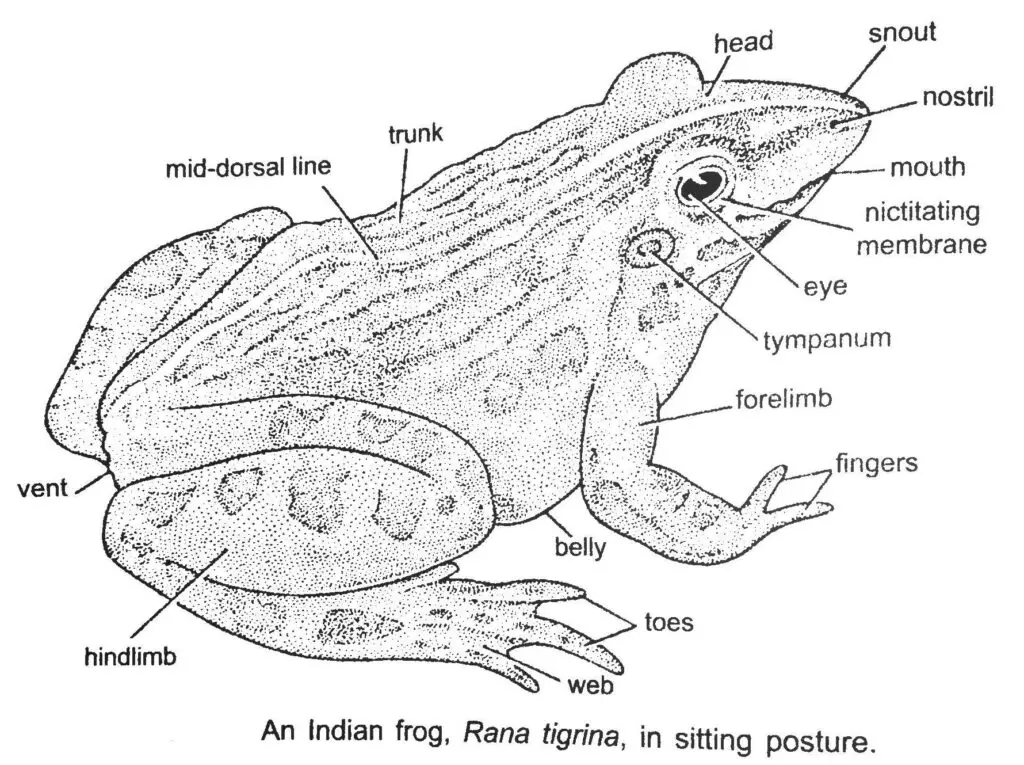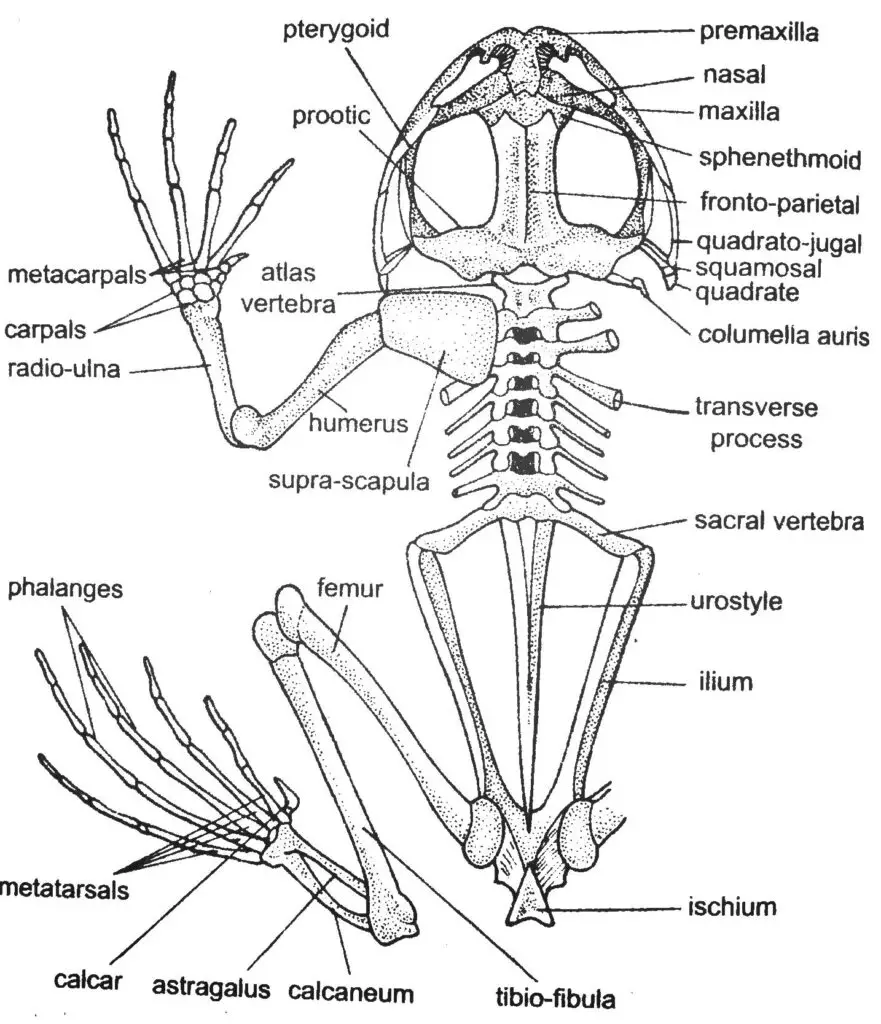Difference between Forelimbs and Hindlimbs of Frog
Frogs move by jumping and swimming and in both of the cases the long hindlimbs play the chief role.
When the frog is in its resting position, the body remains inclined upward in front being supported on the forelimbs with its thumb pointing nearly backward. While the posterior part remains in the ground with the hindlimbs being folded.
The frog uses its hindlimb to leap itself up in the air just like a spring for jumping movements, and the forelimbs provides the direction of jump.
During swimming movements, the hindlimbs help the frog to swim forward by propelling the water backward. The forelimbs help it to swim downward by beating the water upward or swim upward by beating downward.
DO YOU KNOW: Amphibians (which includes frogs, salamanders, etc) were the first group of vertebrates in the Animal Kingdom to develop limbs and to be able to leave the water to conquer the land.

Forelimbs & Hindlimbs of frog
1. FORELIMBS
There are two forelimbs attached to the anterior part of the trunk and each one is situated at each side of the frog’s body. The forelimbs are shorter, while the hindlimbs are larger and athletic in nature.
The forelimbs are used to support the front part of the frog’s body while jumping or while at rest. These also helps to control the movement direction of the frog while swimming or jumping.
Each forelimb comprises of an upper arm, a forearm, wrist, and hand with four digits and vestigial thumb.
The bones of forelimbs include humerus, radio-ulna, and the bones of hand.
2. HINDLIMBS
There are two hindlimbs attached to the posterior part of the trunk and each one is situated at each side of the frog’s body.
Each hindlimb comprises of an upper thigh, lower leg, ankle, and long foot with a narrow sole. The long foot with a narrow sole has five digits connected by broad thin webs of skin which help the frog in swimming.
The bones of forelimbs include femur, tibio-fibula, astragalus-calcaneum, and bones of foot.
Frogs can easily adapt to the surroundings using hindlimbs. The main reason is that the hind limbs are too athletic in nature with strong muscle fibres that allow it to jump high to easily escape its predator and also to catch its prey.
Characteristics of Frog’s forelimb
Forelimbs are those two limbs that are found in the front part of the frog’s body. They use their forelimbs for burrowing, supporting their anterior body, swim upward or downward, or provide direction during a jump.
The forelimbs are used in an alternating fashion in a diagonal sequence one after the other, and that the position of the limbs is adjusted when walking on substrates of different diameters.
The forelimbs also help in providing a proper grip and friction on the substrate in contact. The gripping force shows varied differences between species.
In males, the base of the first (inner) finger is thickened especially in the breeding season, forming the nuptial pad for clasping the female at the time of mating.
After a long jump, the forelimbs due to its great mobility of the digits help the frog to hold on a substrate and get a proper grip. This helps them to avoid damaging the sensitive and soft belly of frogs.
Some species of frogs are even known to use their forelimbs to clean their faces and eyes, and if their prey is not entirely in their mouth they’ll use those arms to push it into their mouth more and better grab the prey.
Characteristics of Frog’s hindlimb
The hindlimbs of frogs are larger than the forelimbs. The hindlimbs are very athletic in nature and help the frog’s heavy body to be lifted high up in the air.
During swimming, the hindlimbs help the frog to move the body forward in the water, in or against the water current.
They do utilize their hind legs in order to easily propel themselves through the water while they are swimming, and they use their front legs in order to steer themselves.
The powerful and sporty style of jumping locomotion in frogs is only powered by the hindlimbs. Hindlimb bones of frogs are highly able to withstand the potentially erratic loads associated with high elastic jumps.
Also, the belly of frogs is not very protected and has relatively very sensitive soft skin. If they didn’t have hindlimbs to land themselves after a high jump, then they would end up slamming into the ground right on their belly.
The best locomotory organ of the frog is its hindlimbs. The main reason is that it can jump high to easily escape from its predator and also to catch its prey.
Many species of frogs have been reported with the ability to burrow soil with their hindlegs. Their toes are tough with claw-like endings that help them to properly grab and move soil.
Many tree frogs have an outstanding ability to climb, and this is achieved due to the vertical climbing power of the hindlimbs.

Anatomy of Frog’s forelimb
The bones of forelimbs include humerus, radio-ulna, and the bones of hand.
Humerus is the bone of upper arm of forelimb. It is short and cylindrical in structure with a slightly curved shaft. It attaches the forelimb with the pectoral girdle.
Radio-ulna is a compound bone of the forearm of forelimb. It is formed by the fusion of radius and ulna bones together.
The bones of the wrist are called carpels and, these carpels are 6 in number and is being arranged in two rows of three each.
The bones of hand includes carpels, ulnare, centrale, radiale, capitohamatum, trapezoid, and trapezium, metacarpels, and phalanges.
The hand is with five slender metacarpals and phalanges. The digit of the thumb is absent with no metacarpals and phalanges.
Anatomy of Frog’s hindlimb
The bones of hindlimbs include femur, tibio-fibula, astragalus-calcaneum, and bones of foot.
Femur is the bone of thigh region of the hindlimb. It is very long and slender having a slightly curved shaft. It attaches the body with the pelvic girdle.
Tibio-fibula is the bone that is formed with the fusion of an inner tibia bone and outer fibula bone.
Astragalus-calcaneum is the bone that supports the ankle of the hindlimbs. It is made up of two rows of four tarsal bones that are fused together at their proximal or distal ends.
The foot is supported by five long and slender metatarsals with phalanges bearing 5 true toes.
How are forelimbs different than hindlimbs in frogs? Let’s know the key differences
Forelimbs are short while the hind limbs are large.
The hindlimbs provide support to the posterior part of the frog’s body while the forelimbs support the anterior part of the frog’s body.
The hindlimbs of frogs are much stronger than the forelimbs. The bones of the hindlimbs are sturdier and longer than the bones present of the forelimbs.
The hindlimbs are attached to the pelvic girdle whereas, the forelimbs are attached to the pectoral girdle.
The forelimbs help in holding the surface, swimming upward or downward in water, provide direction during a jump, rotation, and helps the frog to hold on a substrate and get a proper grip.
The hindlimbs help in climbing, high jumping, escaping from predators, propelling in water, and land the body smoothly after potentially high elastic jumps.
Moreover, the male frogs can be distinguished by the presence of a nuptial pad (thumb pad) on the first digit of the forelimbs (not hindlimbs), which are absent in female frogs.
Tibial macroglans are present on the hindlimbs, and radial macroglands on the forelimbs of frog.
Difference: Frog’s Forelimb vs. Hindlimb
| BASIS FOR COMPARISON | FORELIMB OF FROG | HINDLIMB OF FROG |
|---|---|---|
| LOCATION | At the anterior part of the frog’s body (at trunk part). | At the posterior part of the frog’s body (at trunk part). |
| ATTACHED TO | Pectoral Girdle bone. | Pelvic Girdle bone. |
| BONES OF THE LIMB | Humerus, radio-ulna, carpels, ulnare, centrale, radiale, capitohamatum, trapezoid, and trapezium, metacarpels, and phalanges. | Femur, tibio-fibula, astragalus-calcaneum, metatarsals, and phalanges. |
| SIZE | Shorter than hindlimbs. | Longer than forelimbs. |
| USED FOR | Walking, swimming, rotating, supporting the anterior body, holding, gripping, and burrowing. | Jumping, propelling in water, climbing, supporting the posterior body, and burrowing. |
| NO. OF DIGITS | 4 digits | 5 digits |
| PRESENCE OF WEBBED LIMB | No! Digits are separate and free moving. | Yes! Digits are fused together using a flap of skin. |
| MUSCLES OF THE LIMB | Flexor, biceps, and triceps | Obturator internus (OI), Quadratus femoris (QF), and Pectineus (Pec) |
